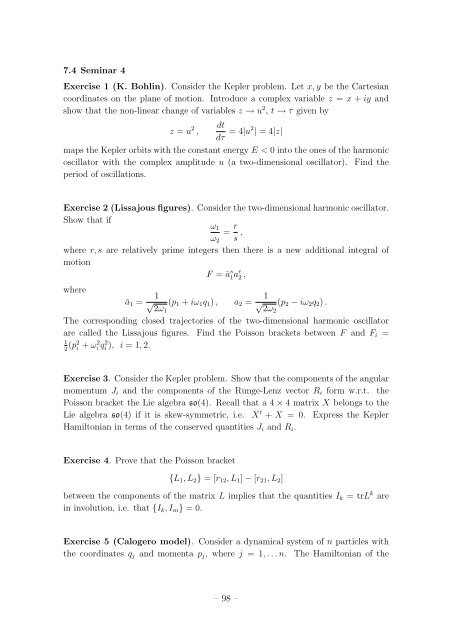Student Seminar: Classical and Quantum Integrable Systems
Student Seminar: Classical and Quantum Integrable Systems
Student Seminar: Classical and Quantum Integrable Systems
You also want an ePaper? Increase the reach of your titles
YUMPU automatically turns print PDFs into web optimized ePapers that Google loves.
7.4 <strong>Seminar</strong> 4<br />
Exercise 1 (K. Bohlin). Consider the Kepler problem. Let x, y be the Cartesian<br />
coordinates on the plane of motion. Introduce a complex variable z = x + iy <strong>and</strong><br />
show that the non-linear change of variables z → u 2 , t → τ given by<br />
z = u 2 dt<br />
,<br />
dτ = 4|u2 | = 4|z|<br />
maps the Kepler orbits with the constant energy E < 0 into the ones of the harmonic<br />
oscillator with the complex amplitude u (a two-dimensional oscillator). Find the<br />
period of oscillations.<br />
Exercise 2 (Lissajous figures). Consider the two-dimensional harmonic oscillator.<br />
Show that if<br />
ω 1<br />
ω 2<br />
= r s ,<br />
where r, s are relatively prime integers then there is a new additional integral of<br />
motion<br />
F = ā s 1a r 2 ,<br />
where<br />
ā 1 = 1 √ 2ω1<br />
(p 1 + iω 1 q 1 ) , a 2 = 1 √ 2ω2<br />
(p 2 − iω 2 q 2 ) .<br />
The corresponding closed trajectories of the two-dimensional harmonic oscillator<br />
are called the Lissajous figures. Find the Poisson brackets between F <strong>and</strong> F i =<br />
1<br />
2 (p2 i + ωi 2 qi 2 ), i = 1, 2.<br />
Exercise 3. Consider the Kepler problem. Show that the components of the angular<br />
momentum J i <strong>and</strong> the components of the Runge-Lenz vector R i form w.r.t. the<br />
Poisson bracket the Lie algebra so(4). Recall that a 4 × 4 matrix X belongs to the<br />
Lie algebra so(4) if it is skew-symmetric, i.e. X t + X = 0. Express the Kepler<br />
Hamiltonian in terms of the conserved quantities J i <strong>and</strong> R i .<br />
Exercise 4. Prove that the Poisson bracket<br />
{L 1 , L 2 } = [r 12 , L 1 ] − [r 21 , L 2 ]<br />
between the components of the matrix L implies that the quantities I k = trL k are<br />
in involution, i.e. that {I k , I m } = 0.<br />
Exercise 5 (Calogero model). Consider a dynamical system of n particles with<br />
the coordinates q j <strong>and</strong> momenta p j , where j = 1, . . . n. The Hamiltonian of the<br />
– 98 –

















